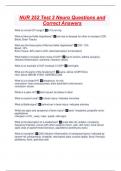NUR 252 Test 3 Neuro Questions and
Correct Answers
What is normal ICP range? ✅5-15 mm Hg
What is Monroe Kellie Hypothesis? ✅one has to derease for other to increase (CSF,
Blood, Brain Tissue)
What are the three parts of Monroe Kellie Hypothesis? ✅CSF- 10%
Blood- 10%
Brain Tissue- 80% (last to shift--decompensation to herniation)
What leads to increase brain mass of IICP? ✅due to tumors, edema (surgery),
infection/inflammation, ischemia, infarction (brain)
What is an example of IICP increase in CSF? ✅meningitis
What are the parts of the tenatorium? ✅supra- above (CORTICAL)
infra- below (BRAIN STEM, CEREBELLUM)
What is a a closed HI? ✅dangerous, no exit;
concussion- lose consciousness, brain back/farth (mild-severe)
contuision- bruise
WHat is a open HI? ✅skull injured, but place to drain
What is racoon's eye? ✅in brain injury- indicates rinnorhea
What is Battle signs? ✅behind ear in brain injury- indicates ottorhea
WHat are signs and symptoms of brain injury? ✅early- headache, projectile vomit,
papillodema
changes in LOC_ early, Later- pupils, vital signs
What is the description of a headaches? ✅onset after 40, sudden, increasing
frequency/intensity, occurs with other systemic (fever, rash, stiff neck), focal nerual
signs (loss of speech/motor/sensory), papilldema (swelling by eyes)
What is menigitis? ✅CNS infection-inflammation of menigneal layers--indicated by
severe HA, photophobia, irritability, meningieal signs (nuchal rigidity, Brud, Kernigs),
paillidema, fever, peticheal rash
, What is a Brudinskis Sign? ✅irritability in neural system, chin to chest
What is a Kernigs signs? ✅knees to chest, autonomic pain in hamstring
What is encephalitis? ✅inflammation/infection of meningeal layers, brain tissue
What is TIA? ✅transient ischemic attack; focal deficit, old (not after 24 hrs) new (brief
neuro dysfunction <1hr), reversible )high risk for CVA)
WHat is CVA? ✅cerebrovascualr accident; sudden focal neurological deficit with
evidence of infarction
infarcted zone- irreversible surrounded by penumbra
What are three etilogies of CVA? ✅thrombus- slow occlusion, middle cerberal artery
embolus- rapid (obstruction of flow in artery)- plaque is most common
hemmhorage- less common, hallmark- headache preceded
What is number one risks of CVA? ✅HTN
What are CVA manifestations? ✅alterted LOC- confusion, lethargy, obtundation, coma
(Glasglow)
Contralateral hemiparesis- opposite; pronator drift, facial droop, reflexic hand grasp
contralateral hemiplegia- 1 side
speech changes
vision changes- diplopia (double vision) hemohem (one sided)
apraxia- lose ability to perform what they normally do
What are CVA speech changes? ✅dysarythia- impaired articulation (cranial nerve
dysfunction)
dysphasia- impaired comprehension/production (cortical)
aphasia- loss of words; expressive (motor), receptive (sensory), left cortical damage
brocas- frontal--talking
wernicke- temproal--comprehension
What are Brocas and Wernickes problems? ✅Brocas- frontal lobe, cant talk
Wernickes- temproal lobe, comprehension
What are changes in IICP due to blood increase? ✅bleed (hemmhorage or
hematomas)
alterted gases (decrease o2 or increase co2--cerbral vasodilation)
HTN- too high >160 systolic, hypo- <100 sytolic--both lower CPP
What are changes in IICP due to CSF increase? ✅hydrocephalus- obstruction of flow,
decrease reabsorption CSF, increase production CSF (in adult- no potential to expand,
child before cranial sultures close can expand)




